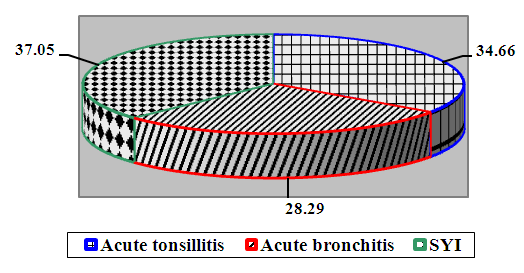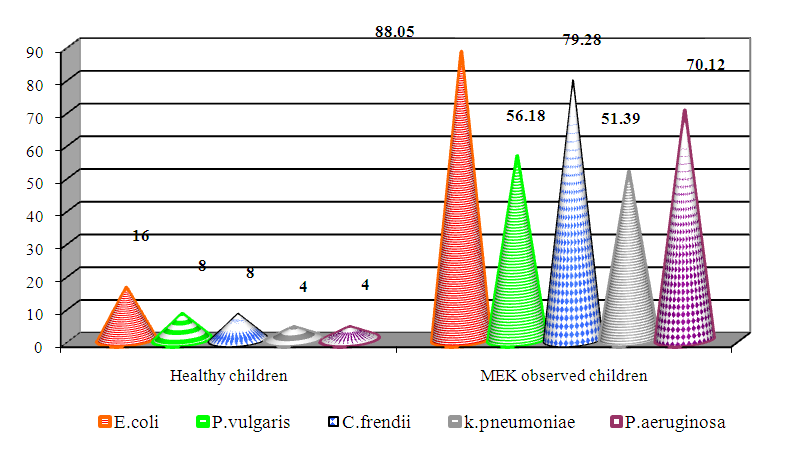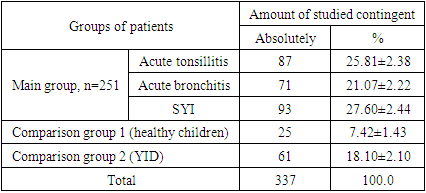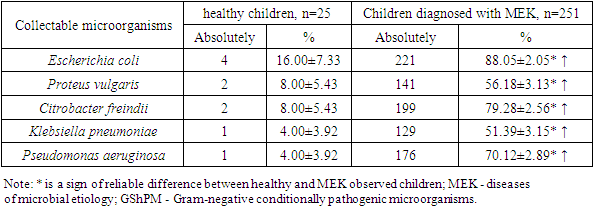-
Paper Information
- Next Paper
- Previous Paper
- Paper Submission
-
Journal Information
- About This Journal
- Editorial Board
- Current Issue
- Archive
- Author Guidelines
- Contact Us
American Journal of Medicine and Medical Sciences
p-ISSN: 2165-901X e-ISSN: 2165-9036
2023; 13(5): 608-611
doi:10.5923/j.ajmms.20231305.13
Received: Apr. 20, 2023; Accepted: May 8, 2023; Published: May 13, 2023

Assessment of the Clinical-Immunological Characteristics of Antiendotoxic Immunity in Diseases of Microbial Etiology in Children
Rozmetov Fakhraddin Nurmatovich1, Nuraliev Nekkadam Abdullaevich2
1Khorezm Region Children's Multidisciplinary Medical Center, Uzbekistan
2Department of Microbiology Immunology and Virology Manager, Bukhara State Medical Institute, Uzbekistan
Copyright © 2023 The Author(s). Published by Scientific & Academic Publishing.
This work is licensed under the Creative Commons Attribution International License (CC BY).
http://creativecommons.org/licenses/by/4.0/

Today, endotoxins of gram-negative bacteria have been studied worldwide, and their differentiation by the fact that they induce the synthesis of various cytokines and other mediators when they enter the human body, that endotoxins are not organotropic from protein toxins, that they have the property of suppressing the phagocytosis process, and that they have non-specific effects, and the role of antitoxic immunity in diseases of bacterial etiology has been shown. but has not been proven to have a high diagnostic value.
Keywords: Antilelo, Grammanfi bacteria, Enotoxin, Antiendotoxic, V-lymphocyte, Intestinal dysbiosis
Cite this paper: Rozmetov Fakhraddin Nurmatovich, Nuraliev Nekkadam Abdullaevich, Assessment of the Clinical-Immunological Characteristics of Antiendotoxic Immunity in Diseases of Microbial Etiology in Children, American Journal of Medicine and Medical Sciences, Vol. 13 No. 5, 2023, pp. 608-611. doi: 10.5923/j.ajmms.20231305.13.
1. Introduction
- It has been proven that all groups of their molecules are responsible for the biological effects of endotoxins of gram-positive bacteria [2]. Antibodies are known to be important humoral antiendotoxin factors. Antibodies against the lipopolysaccharide (LPS) O-chain of gram-positive bacteria have high neutralizing activity, but the high variability of this O-chain reduces the probability of specific antibodies encountering their corresponding endotoxin. Therefore, attention has been paid to the deep determinants of the LPS R-layer, especially antibodies against Re-glycolipid [4].A small amount of endotoxins of representatives of the normal microflora of the human large intestine in the blood has an antigen-stimulating effect on the immune system, strengthens the non-specific resistance of the human body, and increases the anti-tumor activity of cells [2].It is known that endotoxins consist of a complex of proteins and LPS, all groups of the endotoxin molecule are responsible for their biological effect in the body in vivo [3]. LPS penetrates thymus-dependent antigens, polyclonally stimulates V-lymphocytes, activates the complement system in an alternative way, and is considered an adjuvant.It was found that the distal sections of the large intestine are a natural reservoir for gram-negative microflora and their endotoxins. Normally, taking into account the barrier function of the intestine, a relatively small amount of endotoxin enters the blood stream, it binds with Kupffer cells, macrophages, erythrocytes, lipoproteins, other proteins of the blood plasma in the valvular vein system, and undergoes detoxification in hepatocytes [8].It has been shown that up to 6% of normal portal blood is discharged into the systemic blood stream through the portocaval and hepatic anastamoses without entering the liver. The control of LPS release of microorganisms from the intestine into the general bloodstream without entering the liver is mainly carried out by the hypothalamic-pituitary-adrenal gland system, the level of portal bleeding through portocaval anastamoses depends on its functional activity [3]. This allows us to reflect the physiological phenomenon such as the presence of endotoxin in the systemic bloodstream of healthy people in the postulates of "systemic endotoxinemia" and the universal factor in the pathogenesis of human diseases "endotoxin aggression", the development of which is associated with an excess of LPS in the general bloodstream and a deficiency of endotoxin-binding systems.With the introduction of intestinal microflora in babies, there is an increase in the level of antibodies to endotoxin (IgG), their amount was on average 231 ± 21 optical density conditional units in healthy newborns on the fifth day, which indicated the ability of babies to synthesize their own antibodies. Placental passage of maternal antiendotoxin antibodies is one of the factors of natural immunity, which ensures the adaptation of the newborn from the womb to the external life conditions [5].It is known that antibodies are important humoral antiendotoxin factors. Antibodies against the LPS O-chain of gram-negative bacteria have high neutralizing activity, but the high variability of the O-chain of gram-negative bacteria reduces the probability of specific antibodies meeting the corresponding endotoxin.The purpose of the study was to evaluate the diagnostic value of comparative determination of clinical-immunological characteristics of antiendotoxic immunity in children's blood serum in inflammatory diseases of bacterial etiology.
2. Research Material and Method
- As 251 3-12-year-old children diagnosed with inflammatory diseases of bacterial etiology (acute tonsillitis, acute bronchitis, urinary tract infection), 61 colon dysbiosis of the same age and 25 healthy children were taken for comparison.To achieve the goal The blood serum of children suffering from acute tonsillitis, acute bronchitis and urinary tract infections (UTIs) was studied among children living permanently in the region. 251 sick children aged 3-12 years living in the Khorezm region of Uzbekistan were involved in the research, 87 of them (34.66±3.00%) had acute tonsillitis, 71 (28.29±2.84%) had acute bronchitis, 93 (37.05±3.05%) SYI diagnoses were verified (Fig. 1).
 | Figure 1. Distribution level of nosological units diagnosed in children patients included in the main group, % |
|
3. Research Result
- Since these indicators may remain within the normal range in many infectious and somatic diseases, they do not indicate the specific cause of the body's disorders, and their general clinical information may be low, which makes it difficult to choose an adequate treatment for various chronic infectious and inflammatory processes.The use of immunocorrective treatment for the purposes of treatment leads to temporary restoration of decreased indicators of immunocompetent cells, indicators of humoral immunity and non-specific protective factors, and some prolongation of remission.All this requires the search for different approaches to the assessment of the immune status, which can help the doctor to improve the quality of life and the treatment of patients with immune system disorders.These new approaches we used are based on the following key principles:selective increase or decrease of serum antibodies against antigens of microorganisms (gram-negative and gram-positive) - representatives of the normal microflora of the human body, indicates the functional state of the immune system in general or the formation of a secondary immune deficiency;• in inflammatory (infectious) processes, allergic and autoimmune components are involved in the pathogenesis of the disease, and the longer and more severe the inflammatory process, the more clearly expressed are the changes in these components;• dynamic assessment of the degree of microbial sensitization and changes in the amount of natural anti-microbial antibodies allows to answer the question of the direction, increase or decrease of the patient's immune reactions.At the next stage of our scientific work, the results of healthy children and MEK were studied comparatively. In both groups, children's serum seropositive results were compared with seronegative results (Table 2).
|
 | Figure 2. Comparative results of IFA of children's blood serum with antigens of bacteria causing diseases of microbial etiology, % |
4. Conclusions
- According to the obtained results, the following immunological aspects were determined according to the level of detection of antiendotoxic antibodies in the blood serum of children: the level of detection of antibodies against GShPB endotoxins in the blood serum depends on the age of the examined children; it was found that the formation of IID in children causes a sharp increase in the titers of antitoxic antibodies in the blood serum, which are reliably higher than the parameters of healthy children, and a patient diagnosed with MEK is close to the parameters of children; the titer of antitoxic antibodies in blood serum depends on the diagnosed nosological entity, for example, the antibody titer and "high" titer in SYI were higher than in acute tonsillitis and acute bronchitis; antibody titers also depend on the type of GShPB produced against them.
 Abstract
Abstract Reference
Reference Full-Text PDF
Full-Text PDF Full-text HTML
Full-text HTML
